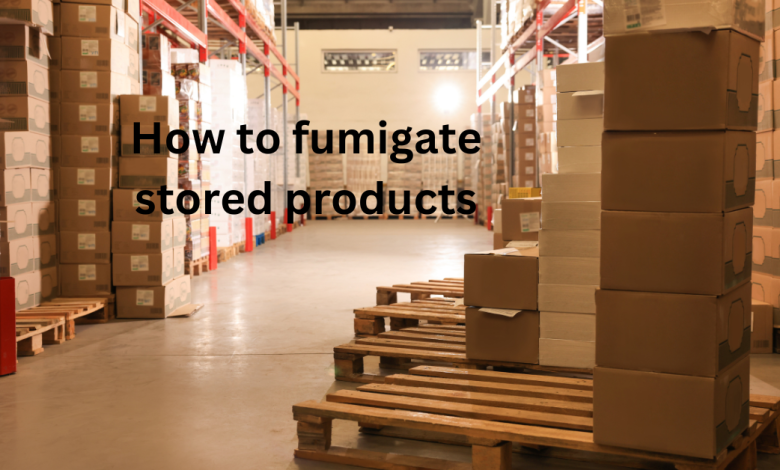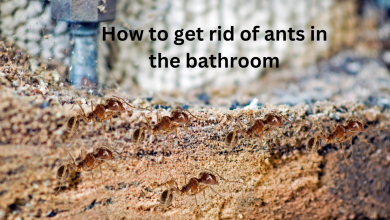Fumigation is an important part of stored product pest control. It involves the use of a fumigant, which is a gas or vapor that penetrates the material and kills pests such as insects, mites, and rodents. To begin fumigation: First remove all food sources from the area to be treated.
Seal any small openings in walls or floors with caulking material. Place plastic sheeting around objects to prevent direct contact with the fumigant. Set up fans to help circulate air throughout the room being treated, then place monitors around it to ensure there are no leaking fumes outside of the designated area.
Finally, set up your fumigator according to instructions and use it safely following safety protocols for handling chemicals.
INTRODUCTION TO THE PRINCIPLES OF STORED PRODUCTS PEST MANAGEMENT
- Step 1: Identify the Pest: The first step in fumigating stored products is to identify the type of pest that has infested them. This can be done by examining any visible signs or damage caused, such as holes in packages, webbing, droppings and dead insects
- Step 2: Choose an Appropriate Fumigant: Once the pest species has been identified, choose a suitable fumigant for eradication. Different pests require different chemicals for effective control and it is important to select one that does not cause harm to humans or other animals
- Step 3: Prepare Area for Fumigation: Before beginning fumigation process itself, make sure that all people and pets are out of the area and seal off any areas where air could escape from before starting the actual procedure
- Step 4 : Apply Fumigant : After preparing area properly , apply appropriate amount of fumiagnt over infected items. Make sure its spread evenly across surface og goods. Also ensure proper safety measures while applying this chemical product like wearing protective gloves etc
- Step 5 : Allow Time For Action : Let the fumiagnt sit on goods for suggested time period determined by manufacturer so it can take effect on pests effectively
- Step 6 : Ventilate Room & Remove Goods After allowing enough time passes , open windows & doors if possible to allow fresh air enter room which will help disperse fumes quickly. Now carefully remove treated goods from area and store them at safe place away from reach of childrens or pets till their smell dissipates completely
Phosphine Fumigation Tablets
Phosphine fumigation tablets are a useful tool for pest control. These tablets contain phosphine gas, which is lethal to pests such as insects and rodents. When used correctly, these tablets can be an effective way of controlling infestations without the use of hazardous chemicals or costly extermination services.
The active ingredient in the tablet slowly releases phosphine gas into your home over a period of time that will eliminate any existing pests, while also protecting against future infestations.
Grain Fumigation Chemicals
Grain fumigation chemicals are used to protect stored grain against insects, rodents, and fungi. These chemicals work by killing or repelling pests that can cause major damage to the grain. Commonly used chemical fumigants include phosphine, ethylene oxide, methyl bromide, carbon dioxide, and sulfuryl fluoride.
Fumigation is a safe and effective way to preserve grains for long-term storage but must be applied carefully in order to protect people from exposure to these potentially harmful substances.
Phosphine Fumigation Dosage
When considering phosphine fumigation, dosage is an important factor. Generally, a minimum concentration of 800 ppm needs to be achieved in order to be effective at killing insect pests; however, higher concentrations may be necessary if the target pest has high resistance or if there are multiple generations present. Additionally, when using phosphine for fumigation purposes it is important to ensure that all areas are adequately treated and that the treatment time is long enough for the gas to reach all potential hiding places where pests may reside.
Phosphine Fumigation Procedure
Phosphine fumigation is a pest control method that involves the release of phosphine gas into an enclosed space. This procedure is used to kill insects and other pests in food storage facilities, mills, ships, and other areas where pests can be found. The process itself generally takes several days to complete; during this time all personnel must evacuate the area while the fumigant disperses throughout to ensure maximum effectiveness.
Once completed, air samples are taken to confirm that all traces of phosphine have been removed before it is safe for reentry.
Grain Fumigation Process
Grain fumigation is a process that involves introducing gases into an enclosed space, such as a grain silo, in order to control and kill pests. This process can be used to protect stored grains from infestation by insects or rodents and help prevent the contamination of food products. Fumigants are typically released through vents in the walls of the grain storage facility and kept at elevated temperatures for several hours before being removed.
During this time, any pests present in the area will be killed due to their inability to tolerate prolonged exposure to these gases.
How Do You Control Stored Product Pests?
Stored product pests, such as moths, weevils and beetles, can be a major problem if they are not controlled. These pests feed on grain-based products, dried fruits and vegetables, nuts and seeds, pet food and other stored foods. To control stored product pests it is important to inspect all incoming shipments for signs of infestation before storing them in your pantry or warehouse.
It is also important to store food items in sealed containers that prevent the entry of pests. Regularly clean shelves and storage areas with a vacuum cleaner to remove spilled grains or crumbs which provide an attractive food source for these insects. Discard any old or moldy foods that may attract them as well as any potential breeding sites including open sacks of grain or flour packages with tears in corners where adult insects could lay their eggs into the contents.
Keeping your storage area dry will discourage the growth of mold – another attractive food source – while keeping humidity levels at 50% prevents adults from laying eggs within products like cereals or flours due to unfavorable conditions for egg hatching success rate.
What Chemical Can I Use to Fumigate?
There are a variety of chemical fumigants available to use when it comes to fumigating a space. The most common chemical used is methyl bromide, which has been widely used for more than 75 years as an effective and efficient means of controlling insects, rodents, and other pests. It works by killing the pests through inhalation or direct contact with the gas that is released into the area being treated.
Other chemicals that can be used for
fumigation include phosphine, carbon dioxide, hydrogen cyanide, chloropicrin and formaldehyde. Each type of chemical has its own unique set of advantages and disadvantages in terms of efficiency, safety and cost effectiveness; therefore it is important to research each before deciding on one particular product for your needs. Properly using these chemicals safely requires expert knowledge so please consult a professional if you need help selecting the right option for you!
What is Fumigation in Storage?
Fumigation in storage is a form of pest control that uses an airtight chamber to create and maintain a lethal environment for pests. This process often involves the introduction of an insecticide, such as sulfur dioxide or methyl bromide, into the closed space. Fumigation kills all stages of insects including eggs, larvae, and adults — making it one of the most effective methods of eliminating infestations.
It’s also widely used in warehouses and other commercial settings where food items are stored due to its ability to prevent contamination from bugs or other pests before they have a chance to cause damage. It also plays an important role in
pest control for construction sites. The highly concentrated gas reaches deep into cracks and crevices where some pests may be hiding out undetected – ensuring complete eradication with fewer treatments than traditional applications like sprays or granular baits. Furthermore, fumigation can be tailored specifically to target certain species without harming beneficial insects like honeybees or ladybugs which can help preserve natural balance in surrounding areas outside your facility.
How Long Does Phosphine Fumigation Take?
Phosphine fumigation is an effective method for controlling pest infestations, including those of stored products such as grains and seeds. Generally speaking, the fumigation process can take anywhere from a few hours to several days depending on the size of the area being treated. To begin with, phosphine gas must first be generated either by reacting aluminum metal with water or acid in a closed container or by using tablets that release phosphine gas when they come into contact with moisture.
Once it has been released into the atmosphere, phosphine will spread throughout the enclosed space killing any pests present within it-provided that proper ventilation guidelines have been followed during set-up and implementation. After all visible signs of life have ceased inside the treatment area, typically after 24 to 48 hours, fresh air should then be allowed to enter in order to reduce concentrations of phosphine below hazardous levels before entry is permitted again.
Conclusion
Fumigating stored products is an effective way to protect them from pests. The process can be done safely at home, without the need for hazardous chemicals or professional help. By following the instructions in this guide, you should have all the information necessary to properly fumigate your stored products and keep them safe from contamination.
With proper care, these methods will ensure that your stored products remain free of pests and their harmful infestations.
Read Also:
Fornez.com




